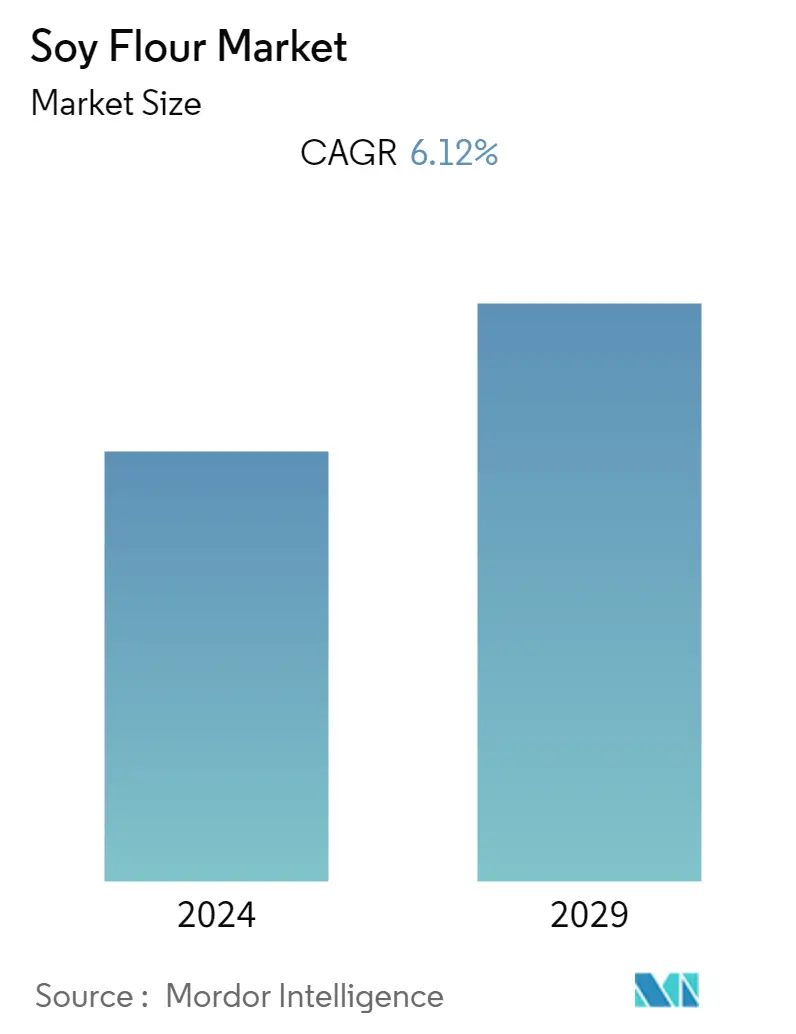Market Size of Soy Flour Industry

| Study Period | 2019 - 2029 |
| Base Year For Estimation | 2023 |
| CAGR | 6.12 % |
| Fastest Growing Market | North America |
| Largest Market | Asia Pacific |
| Market Concentration | Low |
Major Players
*Disclaimer: Major Players sorted in no particular order |
Soy Flour Market Analysis
The Global Soy Flour Market is expected to register a CAGR of 6.12%, during the forecast period of 2019–2024.
- Growing demand for soy-derived flour in processed baked items owing to its nutritional qualities including gluten-free, trans-fat free, and whole-grain food products are fueling the soy flour market growth.
- Additionally, the rising popularity of a vegan diet is expected to propel the demand for soy flour owing to its nutritional value such as high dietary fiber and bioactive components including isoflavones. Moreover, flour derived from soy has a gluten-free property and it acts as a prime source of protein in a vegan diet, this, in turn, boosting the soy flour market globally.
Soy Flour Industry Segmentation
Global Soy Flour Market is segmented by type, application, and geography. On the basis of type, the market is segmented intodefatted and full-fat. On the basis ofapplication, the market is segmented intobakery & confectionery, meat substitutes, meat and poultry, soups and sausages, and others.By geography, the study provides an analysis of the soy flour market in the emerging and established markets across the globe, including North America, Europe, Asia-Pacific, South America, and Middle East & Africa.
| Type | |
| Defatted | |
| Full Fat |
| Application | |
| Bakery & Confectionery | |
| Meat Substitute | |
| Meat and Poultry | |
| Soups and Sausages | |
| Others |
| Geography | |||||||||
| |||||||||
| |||||||||
| |||||||||
| |||||||||
|
Soy Flour Market Size Summary
The soy flour market is experiencing significant growth, driven by the increasing demand for soy-derived flour in processed baked goods due to its nutritional benefits, such as being gluten-free, trans-fat free, and a source of whole-grain products. The rising popularity of vegan diets further propels this demand, as soy flour offers high dietary fiber and bioactive components like isoflavones, making it a crucial protein source for vegans. The market is also benefiting from the functional properties of modified soy flour, which enhances the characteristics of food products it is added to, and its growing use in various industrial applications. This trend is expected to continue, contributing to the expansion of the functional flour market.
Regionally, North America leads the soy flour market, with the United States being a major contributor due to the increasing consumer interest in vegan diets. The Asia Pacific region is the fastest-growing market, with Japan being a significant consumer due to its traditional food practices. The market is characterized by fragmentation, with key players like Archer Daniels Midland Company, Cargill, Incorporated, and DuPont actively introducing new products to meet evolving consumer preferences. These developments are anticipated to broaden the application of soy flour in the food industry, enhancing its market presence during the forecast period.
Soy Flour Market Size - Table of Contents
-
1. MARKET DYNAMICS
-
1.1 Market Drivers
-
1.2 Market Restraints
-
1.3 Porter's Five Force Analysis
-
1.3.1 Bargaining Power of Suppliers
-
1.3.2 Bargaining Power of Buyers/Consumers
-
1.3.3 Threat of New Entrants
-
1.3.4 Threat of Substitute Products
-
1.3.5 Intensity of Competitive Rivalry
-
-
-
2. MARKET SEGMENTATION
-
2.1 Type
-
2.1.1 Defatted
-
2.1.2 Full Fat
-
-
2.2 Application
-
2.2.1 Bakery & Confectionery
-
2.2.2 Meat Substitute
-
2.2.3 Meat and Poultry
-
2.2.4 Soups and Sausages
-
2.2.5 Others
-
-
2.3 Geography
-
2.3.1 North America
-
2.3.1.1 United States
-
2.3.1.2 Canada
-
2.3.1.3 Mexico
-
2.3.1.4 Rest of North America
-
-
2.3.2 Europe
-
2.3.2.1 United Kingdom
-
2.3.2.2 Germany
-
2.3.2.3 France
-
2.3.2.4 Russia
-
2.3.2.5 Italy
-
2.3.2.6 Spain
-
2.3.2.7 Rest of Europe
-
-
2.3.3 Asia Pacific
-
2.3.3.1 China
-
2.3.3.2 India
-
2.3.3.3 Japan
-
2.3.3.4 Australia
-
2.3.3.5 Rest of Asia-Pacific
-
-
2.3.4 South America
-
2.3.4.1 Brazil
-
2.3.4.2 Argentina
-
2.3.4.3 Rest of South America
-
-
2.3.5 Middle East & Africa
-
2.3.5.1 UAE
-
2.3.5.2 Saudi Arabia
-
2.3.5.3 Rest of Middle East & Africa
-
-
-
Soy Flour Market Size FAQs
What is the current Soy Flour Market size?
The Soy Flour Market is projected to register a CAGR of 6.12% during the forecast period (2024-2029)
Who are the key players in Soy Flour Market?
Archer Daniels Midland Company, Cargill, Incorporated, CHS Inc., DuPont and SunOpta are the major companies operating in the Soy Flour Market.

